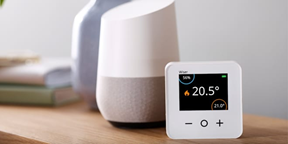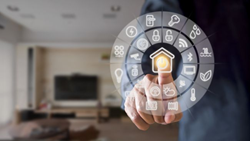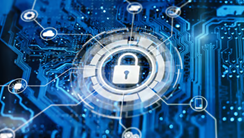Smart Home Innovations for 2024
By Chalith Desaman.In the rapidly evolving landscape of technology, smart homes have emerged as a beacon of convenience, efficiency, and sustainability. As we step into 2024, the realm of smart home innovations continues to expand, offering homeowners an unprecedented level of connectivity and control over their living spaces.

AI-Powered Home Assistants
Forget about giving static voice commands; nowadays, AI home assistants are like smart buddies that get what we need without us even saying it. In 2024, they're going to be even better at blending into our daily lives. Using fancy language skills and clever algorithms, they'll handle chores like adjusting the temperature, ordering groceries, and suggesting stuff we like. These smart helpers are about to become must-haves in our homes.

- Amazon Echo with Alexa:
Alexa is Amazon's virtual assistant that powers devices like the Echo, Echo Dot, and Echo Show. It can perform various tasks, such as setting reminders, controlling smart home devices, playing music, and providing weather updates.
- Google Nest with Google Assistant:
Google Assistant powers the Nest line of smart home devices, including the Nest Hub, Nest Mini, and Nest Thermostat. It can answer questions, control smart home devices, manage schedules, and play media.
- Apple HomePod with Siri:
Siri is Apple's virtual assistant, and it powers the HomePod smart speaker. Siri can perform tasks like setting reminders, sending messages, playing music, controlling smart home devices, and answering questions.
- Samsung SmartThings with Bixby:
Bixby is Samsung's virtual assistant, and it is integrated into the SmartThings ecosystem. It allows users to control smart home devices, set routines, and access various services using voice commands.
- Microsoft Cortana:
Cortana is Microsoft's virtual assistant, and it can be used with various smart home devices and platforms. It can help with tasks like managing calendars, setting reminders, sending emails, and controlling smart home devices.
Enhanced Energy Management
As everyone focuses more on being eco-friendly, smart homes are stepping up to save energy and help the planet. In 2024, there will be lots of new ways to use energy better, like smart thermostats that adjust automatically and solar panels that give us power from the sun. These changes don't just save money on bills; they also make the world cleaner and healthier for the future.

- Smart Thermostats:
Devices like the Nest Learning Thermostat or Ecobee SmartThermostat use sensors and algorithms to learn household patterns and adjust heating and cooling settings accordingly. This not only improves comfort but also reduces energy waste by avoiding unnecessary heating or cooling when nobody is home.
- Energy Monitoring Systems:
Devices such as Sense or Neurio provide real-time insights into energy usage within the home. Users can identify energy-hungry appliances, set energy-saving goals, and receive alerts about unusual energy consumption patterns, allowing for more informed decision-making and behavior adjustments to save energy.
- Home Energy Storage Solutions:
Battery storage systems like the Tesla Powerwall or LG Chem RESU enable homeowners to store excess energy generated by solar panels during the day for use during peak demand periods or at night. This helps to optimize energy usage, reduce reliance on the grid, and potentially save money on electricity bills.
- Demand Response Programs:
Smart home platforms, such as Google Nest or Samsung SmartThings, can participate in demand response programs where energy providers incentivize users to reduce energy consumption during periods of high demand. These platforms can automatically adjust smart thermostats, water heaters, and other devices to lower energy usage during peak times, helping to stabilize the grid and avoid blackouts.
- Integration with Renewable Energy Sources:
Smart home systems can seamlessly integrate with renewable energy sources like solar panels or wind turbines. By coordinating energy production with household consumption patterns, these systems maximize the use of clean energy and minimize reliance on fossil fuels, contributing to a more sustainable energy ecosystem.
Seamless Integration of IoT Devices
The Internet of Things (IoT) is growing fast, connecting everything from smart appliances to security cameras. In 2024, the focus will be on making all these devices work together smoothly. Whether you're using your phone to control your smart locks or getting alerts from different devices, the goal is to create easy-to-use smart home systems that make life simpler and more secure.

- Smart Home Hubs:
Devices like Samsung SmartThings, Google Nest Hub, and Amazon Echo Plus serve as central hubs that connect and control various IoT devices within the home. These hubs typically support multiple communication protocols like Wi-Fi, Zigbee, and Z-Wave, allowing users to manage diverse devices from different manufacturers through a single interface.
- Voice Assistants:
Virtual assistants like Amazon Alexa, Google Assistant, and Apple Siri enable voice control of IoT devices. Users can issue voice commands to perform tasks such as adjusting lighting, controlling thermostats, and playing music across different IoT ecosystems, creating a seamless and intuitive user experience.
- Unified Mobile Apps:
Many smart home device manufacturers offer mobile apps that allow users to control and monitor their devices remotely. These apps often support integration with third-party devices, enabling users to manage multiple IoT devices from different brands within a single app interface.
- If This, Then That (IFTTT) Integration:
Platforms like IFTTT enable users to create custom automation sequences, or "applets," that connect IoT devices and services together. For example, users can create applets to turn on smart lights when motion is detected by a security camera or to receive notifications when a smart doorbell is pressed, enhancing the interoperability and functionality of IoT devices.
- Home Automation Platforms:
Comprehensive home automation platforms like Home Assistant, OpenHAB, and Hubitat Elevation provide advanced customization and integration capabilities for IoT devices. These platforms allow users to create complex automation routines, establish device triggers and conditions, and unify control of diverse IoT devices through a centralized dashboard or interface.
Personalized Home Automation
As smart homes get better, people will have more chances to customize them to fit their lives perfectly. In 2024, look out for AI-powered systems that learn from how you live and create personalized routines. They might adjust lights to match your daily rhythms, make security smarter based on when you're home, or set up entertainment just how you like it. There are so many ways to make your home work just for you.

- Adaptive Lightning:
Smart lighting systems like Philips Hue or LIFX can be programmed to adjust brightness, color, and timing based on user preferences and daily routines. For example, lights can gradually brighten in the morning to simulate sunrise, dim in the evening to promote relaxation, and change colors to match specific activities or moods
- Intelligent Climate Control:
Smart thermostats such as Ecobee or Nest Learning Thermostat can learn household occupancy patterns and temperature preferences to automatically adjust heating and cooling settings. They can also integrate weather forecasts to optimize energy usage and comfort levels, ensuring personalized climate control throughout the day.
- Customized Security Settings:
Home security systems like Ring or SimpliSafe can be tailored to individual preferences, with features such as customizable motion detection zones, personalized notifications, and scheduling of security modes based on occupancy patterns. Users can receive alerts and access live video feeds from security cameras to monitor their homes remotely, providing peace of mind and personalized security.
- Entertainment Automation:
Smart entertainment systems like Sonos or Logitech Harmony can be programmed to create personalized audio and video experiences. Users can set up custom routines to play specific music playlists, adjust volume levels, and control compatible devices such as TVs and streaming platforms based on their preferences and activities
- Health and Wellness Integration:
Smart home devices like fitness trackers, sleep monitors, and smart scales can integrate with automation platforms to provide personalized insights and recommendations for health and wellness. For example, data from sleep tracking devices can be used to adjust bedroom lighting and temperature settings to promote better sleep quality, while fitness goals can trigger reminders for physical activity or healthy eating habits.
Enhanced Privacy and Security Measures
As smart homes connect more, keeping them safe will be a big worry for owners. In 2024, there'll be more attention on using strong security measures like encryption and authentication to protect personal info. Companies will work on new ways, like biometrics and blockchain, to make sure your data stays private and safe, so you can enjoy the perks of a connected home worry-free.

- End-to-End Encryption:
Smart home devices and platforms employ end-to-end encryption to ensure that data transmitted between devices and servers is securely encrypted and cannot be intercepted or accessed by unauthorized parties. For example, messaging apps like Signal and WhatsApp use end-to-end encryption to protect users' conversations from eavesdropping.
- Two-Factor Authentication (2FA):
Smart home platforms and mobile apps implement two-factor authentication to add an extra layer of security beyond just a password. Users are required to provide a second form of verification, such as a unique code sent to their mobile device or generated by an authentication app, to access their accounts and devices.
- Privacy-Centric Design:
Smart home devices and platforms are designed with privacy in mind, incorporating features such as privacy settings, data anonymization, and user consent mechanisms. For example, smart speakers like the Apple HomePod have physical mute buttons that physically disconnect the microphone, giving users control over when their voice commands are recorded.
- Regular Software Updates:
Smart home device manufacturers release regular software updates to patch security vulnerabilities and improve overall system security. These updates may include security patches, bug fixes, and enhancements to encryption algorithms to keep devices protected against emerging threats and attacks.
- User Education and Awareness:
Smart home users are provided with educational resources and guidelines to help them understand and mitigate security risks. Manufacturers offer user manuals, online tutorials, and support forums to educate users about best practices for securing their smart home devices, such as creating strong passwords, avoiding public Wi-Fi networks, and regularly updating firmware.
Looking to 2024 and beyond, smart homes hold endless potential. With AI helpers, energy savings, seamless device connections, and personalized setups, our living spaces can be truly amazing. By using these advancements wisely and focusing on privacy and security, we can build homes that make life better while also helping the planet. Welcome to the future of home automation, where convenience and care come together to make life easier and brighter.

